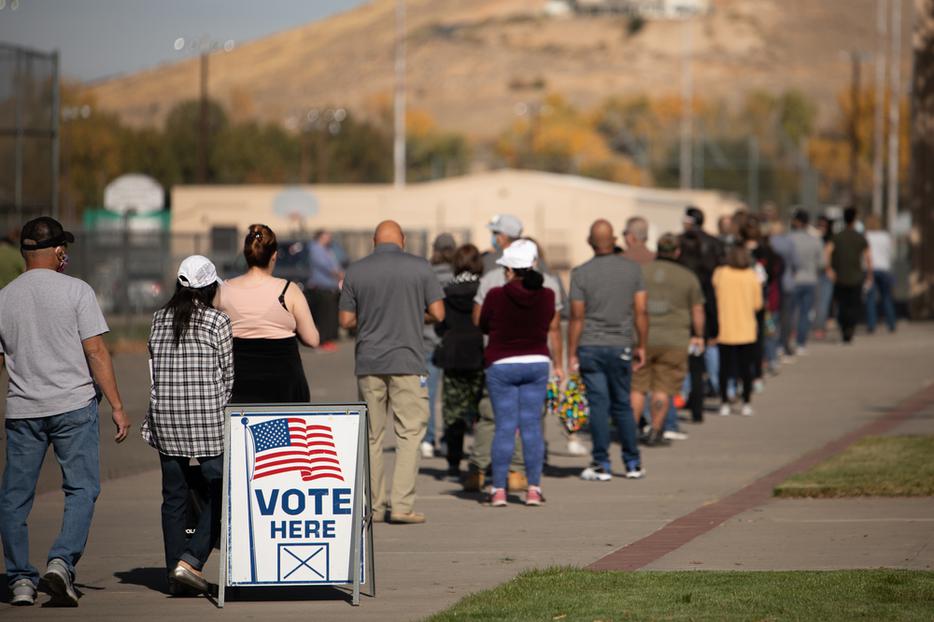With or Without Trump, 2020 Election Indicates Opportunities for Republican Party
As the political landscape shifts, the GOP is poised to maintain its social conservatism while becoming more racially diverse, pro-working class and — according to some — consistent with the breadth of Church teaching.

Party Paradigm Shift?
Voters 2016 2020
Non-white overall 21% 26%
Black voters 8% 12%
Latino voters 28% 32%
Asian voters 29% 31%
Whether Donald Trump retains his residence in the White House come 2021 or not, one thing seems clear: The Republican Party has an unprecedented opportunity to become a home for a fusion of social conservatism and multiracial, economic populism.
The possibility has become a dominant post-election point of conversation among Catholic commentators, many of whom see such a shift as a promising sign that in America’s political landscape, where social-justice issues and the pro-life cause tend to be artificially separated, at least one of the major parties will move toward greater consistency with the Church’s complete social vision.
“[A m]ulti-racial coalition of the working class is effectively the party of Catholic Social Teaching,” tweeted Notre Dame political theorist Patrick Deneen.
Hope in such a shift is based on preliminary data indicating the highest level of non-white support for a Republican presidential candidate in 60 years. In the 2020 elections, Trump earned the votes of 26% of the demographic, improving 5% from his 2016 results. By comparison, the average share of non-white support for a GOP candidate in the four previous elections was less than 12%, with Trump’s 2020 figure the highest since 1960, when Richard Nixon earned 32% of non-white votes.
Trump’s gains among non-whites applied across different racial groups, with increases in overall support among Black voters (+4 to 12%), Latinos and Hispanics (+4 to 32%), and Asians (+2 to 31%).
The gains among Latinos, in particular, were staggering in particular counties, such as Texas’ Starr County, located in the Rio Grande Valley. Trump dramatically improved his support in the county, reportedly the most predominantly Hispanic one in the U.S., from 17% in 2016 to 47% in 2020. The president also made significant gains among Latinos in Democratic strongholds like Miami-Dade County in Florida, where he performed roughly equal with his opponent, former Vice President Joe Biden.
The gains among non-white voters, which happened in an election with historically high turnout, may be especially relevant in a country where the electorate is becoming increasingly diverse. Since 2000, 76% of growth in the voting population has been among non-whites.
Coupled with Trump’s gains among non-whites was his continued rapport with blue-collar voters, who’ve historically voted Democrat. Although the president’s level of support from union members fell below 40% in states like Michigan and Wisconsin, he still performed better than typical GOP candidates and likely increased his share of blue-collar workers in other states, like Ohio.
Reasons for the Realignment
Media accounts have attributed Trump’s performance with non-whites and blue-collar workers to the president’s “strongman style” and his promises of material wealth, or to Biden’s apparent neglect of key demographics. But some Catholic commentators point out a different possible factor: increasing alienation from the rising secular progressivism of the Democratic Party.
“Most of these narrative-shattering votes were almost certainly not for Trump, but against a Democratic Party perceived as hostile to the traditional and religious views of Latinos and African Americans,” said Charles Camosy, a Fordham University moral theologian and longtime pro-life Democrat who left the party this year over its extremist views on abortion. In support of this view, Camosy points out that while Trump was consistent during his first term, “the percentage of those with extremist views on the left sure changed.”
A report from NPR the day after Election Day suggests that the Christian faith of Latinos was a likely factor in shifts away from Biden, who abandoned long-standing opposition to federal funding for abortion during the Democratic primaries, and toward Trump.
Chad Pecknold notes that Republicans may be moving to claim the socially conservative, economically liberal and racially diverse ground that Democrats occupied decades ago — “before they moved to the far left as the coastal laptop class.”
“Democrats have become the party of woke capital and urban elites, whereas the Republicans have become a multiethnic party of the poor,” Pecknold, a political theologian at The Catholic University of America, told the Register.
Statements of such a complete transformation may be premature, but one thing’s true: More white people, who tend to be less religious and more affluent than most of their non-white peers, voted for the Democratic contender for president than they did in 2016. White men, in particular, supported Biden at a rate 13% higher than they did Hillary Clinton. Additionally, The Associated Press’ analysis of voters shows that 72% of those with no religious affiliation voted for Biden.
Mary Rice Hasson, the director of the Catholic Women’s Forum, believes Democrats’ perceived hostility to traditional religious beliefs will continue to divide Americans, likely pushing believers from historically pro-Democrat demographics into the GOP, “because beliefs play out in how people live and the policies they support.”
In comments to the Register, Princeton University political philosopher Robert George says the lack of a landslide Democratic victory and their failure to take the Senate makes clear that even if Trump is repudiated and fails to earn a second term, the combination of social conservatism and economic populism he helped to normalize in the GOP will have longevity beyond him.
George suggests that what has been truly repudiated are ideas once popular among the GOP establishment that the party would need to shift leftward on social issues to remain nationally competitive.
“The lasting consequences of the Trump phenomenon is that the Republican Party now sees that its elites were wrong and Trump was right,” said the prominent Catholic intellectual, who characterizes this potential direction of the GOP as a clear departure from the Reaganism of the 1980s.
George adds that with a new openness to economic populism, the GOP will have new opportunities to reach out to Blacks and Latinos — whose relative social conservatism and religiosity might have made them natural fits as Republicans before, if not for perceptions that the party was more committed to the bottom-line for big corporations than it was to the conditions of people living in lower socioeconomic conditions.
“That impediment has gone away.”
Carrying the Mantle Forward
Trump may have helped usher in this new approach for the GOP, but some commentators note that others will have even more success bringing it forward.
“Trump has actually opened up doors in the African American and Latino community that other Republicans can go through that he can’t because of his character,” said former Pennsylvania Sen. Rick Santorum in a Nov. 4 talk to the Napa Institute, referring to Trump’s divisiveness and lack of discipline.
One potential champion of a new brand of GOP politics, frequently mentioned by those interviewed for this story, is Josh Hawley, the junior senator from Missouri. George says the 40-year-old, who tweeted, “We are a working-class party now. That’s the future” on Election Day, has internalized the message of economic populism and social conservatism “like nobody’s business” and has the personality to make it more palatable to a wider audience.
Florida Sen. Marco Rubio has also repositioned himself as more of an economic populist since he lost to Trump in the 2016 Republican primaries. The Catholic politician has advocated for “common-good capitalism,” an economic vision that takes society’s obligations to the poor and to families more seriously, and recently tweeted that the future of the GOP is “a party built on a multiethnic, multiracial coalition of working Americans.”
However, some warn against such confident claims of a Republican makeover.
“I am all in for the pan-ethnic, working-class conservatism, but [it’s] worth stressing that the (wildly provisional, probably wrong) exit polls only show modest movement of minorities relative to 2016; it’s an indicator of possibilities, not a sea change,” said Catholic New York Times columnist Ross Douthat on Twitter.
John Carr, director of Georgetown University’s Initiative for Catholic Social Thought and Public Life, told the Register that many Catholics feel politically homeless following this election and suggested that some will continue to feel alienated from the GOP so long as Trump — in office or not — is seen as a figurehead of it.
Stephen White, a fellow in Catholic Studies at the Ethics & Public Policy Center, cautions that building an electoral coalition in a time of division is far easier than building a viable governing coalition.
“The latter would have to be built around positive principles and concrete policies, rather than on Trump’s personality, opposition to common enemies, or fear of the radical left,” said White, author of Red, White, Blue and Catholic. “In short, the path from a coalition willing to reelect Trump to a coalition willing to govern as many conservatives with Trump would govern is not likely to be an easy one.”
Political Accountability
Another challenge? Holding Republican politicians who claim to be part of the new coalition accountable.
“The Johnny-Come-Latelys are welcome,” tweeted Sohrab Ahmari, New York Post op-ed editor and Catholic commentator. “But it’s up to those of [us] who’ve been pushing to bury the Dead Consensus to hold them accountable: [I]t’s not enough to just say the words — you have to deliver.”
The American Solidarity Party (ASP), a third party inspired by Catholic social teaching, weighed in on the topic on Twitter, citing “a huge opening” for “upper-left quadrant” politics, given the Democrat’s extreme views on abortion and downplaying of their traditional economic platform.
“But if the GOP ever gets there it will require more than just a slight re-branding.”
Camosy, who endorsed ASP this year, agrees and emphasizes that the more liberal economic views of non-whites will need to be accounted for if Republicans are serious about a transformation. However, even though he intends to continue his support for the ASP, Camosy says that a Republican Party that embraced social conservativism, economic populism and racial diversity would be “a very exciting and hopeful development.”
“It would be a very different Republican Party from the one I grew up with, but it would be one that was much more consistent with the fullness of Catholic teaching.”
- Keywords:
- trump
- 2020 election
- GOP
- paradigm shift
- latinos for trump
- democrats for life
- charles camosy

















